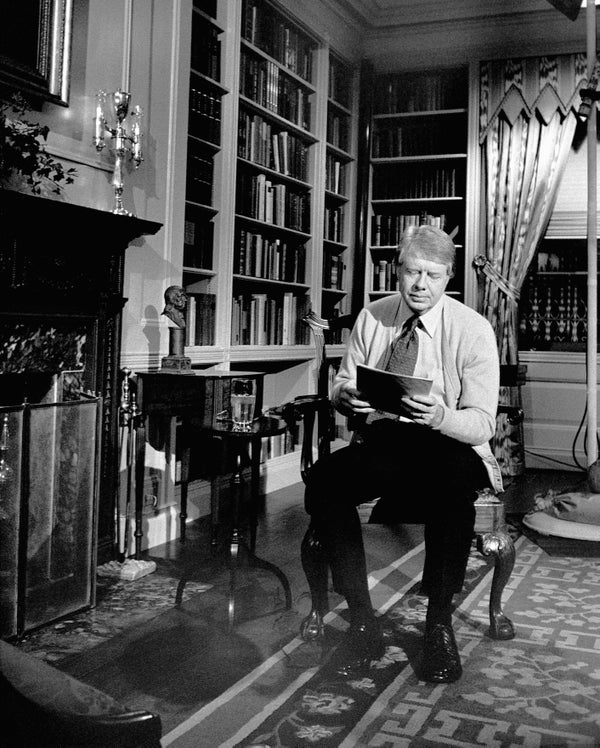
7 Ways Jimmy Carter Has Improved America’s Energy Future—Or Tried To
As U.S. president, Jimmy Carter championed renewable energy, conservation and other then fringe efforts that are powerhouses today

Former U.S. president Jimmy Carter entered hospice care at his Plains, Ga., home last month. Much has been written about his legacy of stamping out Guinea worm disease, creating affordable housing through Habitat for Humanity and inspiring cancer patients with his own successful fight against metastatic melanoma. Carter may also be the politician who, more than any other, changed the country’s energy future. Under his four years of American leadership, landmark events and legislation opened up a new world of “alternative energy” as a way to wean the country from its troublesome reliance on fossil fuels. Here are seven highlights from the beginning to end of his term.
The 1973 oil embargo shocked the world. Countries belonging to the Organization of Petroleum Exporting Countries cut exports to the U.S. as retribution for supporting Israel in the 1973 Arab-Israeli War, causing prices to rise steeply. On February 2, 1977, Carter addressed the nation on television while sitting next to a roaring fire in the White House Library, wearing a sweater. He encouraged Americans to help lessen the country’s dependence on foreign oil by taking steps to reduce energy usage, including turning down their home thermostat.
If you're enjoying this article, consider supporting our award-winning journalism by subscribing. By purchasing a subscription you are helping to ensure the future of impactful stories about the discoveries and ideas shaping our world today.
On April 18, 1977, Carter addressed the nation again, saying it had to stridently reduce dependence on overseas oil with a fervent, unified effort that was the “moral equivalent of war.”
The 1970s oil crisis also showed how disjointed the federal government’s handling of energy was. Carter and Congress together took steps to create the DOE, which he signed into law on August 4, 1977, to oversee national energy policy and to consolidate the various agencies involved.
To create a buffer against future embargoes or supply interruption, in 1975 the U.S. established the Strategic Petroleum Reserve (SPR). The government would buy oil on the market and store it. Under Carter, underground salt domes in Louisiana and Texas were selected as the storage sites in April 1977, and he began to fill the reserve in July 1977. Today the SPR’s maximum capacity is 714 million barrels. Various presidents have occasionally tapped it to try to bring down high retail gasoline prices by adding supply to the market. They include George H. W. Bush, who utilized the SPR during Operation Desert Storm in 1991, and George W. Bush, who did so after Hurricane Katrina in 2005. In 2022 Joe Biden released oil from the reserve when low global production and supply chain interruptions kept prices well above $4 a gallon.
This one piece of legislation jump-started a number of initiatives that were rooted in the idea of conserving energy. Before then, energy was largely seen as cheap and unlimited. The act had provisions to reduce energy demand, to promote greater use of domestic energy sources—especially renewable sources—through taxes and tax credits and to raise fuel efficiency.
In the summer of 1979 Carter had 32 solar panels installed on the White House roof to reflect his belief in “clean,” renewable energy sources. The panels heated water for household use. They remained in place until 1986, when then president Ronald Reagan had them removed.
This package had several bills that all boosted what had previously been widely viewed as fringe energy sources. These bills increased support for synthetic fuels, as well as biomass, solar, geothermal and ocean energy. They again emphasized conservation through greater efficiency.
Mark Fischetti has been a senior editor at Scientific American for 17 years and has covered sustainability issues, including climate, weather, environment, energy, food, water, biodiversity, population, and more. He assigns and edits feature articles, commentaries and news by journalists and scientists and also writes in those formats. He edits History, the magazine's department looking at science advances throughout time. He was founding managing editor of two spinoff magazines: Scientific American Mind and Scientific American Earth 3.0. His 2001 freelance article for the magazine, "Drowning New Orleans," predicted the widespread disaster that a storm like Hurricane Katrina would impose on the city. His video What Happens to Your Body after You Die?, has more than 12 million views on YouTube. Fischetti has written freelance articles for the New York Times, Sports Illustrated, Smithsonian, Technology Review, Fast Company, and many others. He co-authored the book Weaving the Web with Tim Berners-Lee, inventor of the World Wide Web, which tells the real story of how the Web was created. He also co-authored The New Killer Diseases with microbiologist Elinor Levy. Fischetti is a former managing editor of IEEE Spectrum Magazine and of Family Business Magazine. He has a physics degree and has twice served as the Attaway Fellow in Civic Culture at Centenary College of Louisiana, which awarded him an honorary doctorate. In 2021 he received the American Geophysical Union's Robert C. Cowen Award for Sustained Achievement in Science Journalism, which celebrates a career of outstanding reporting on the Earth and space sciences. He has appeared on NBC's Meet the Press, CNN, the History Channel, NPR News and many news radio stations. Follow Fischetti on X (formerly Twitter) @markfischetti